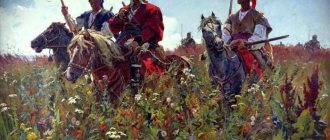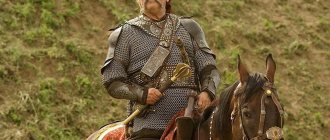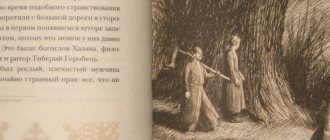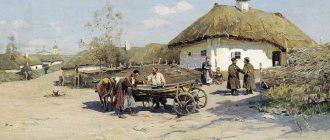The main meaning of the work
The constant atmosphere of danger, betrayal and heroism allows you to keep the reader in suspense. The work “Taras Bulba” is as close as possible to a historical epic and heroic novel. The life of the Sich is described in detail, a picture of the Ukrainian steppe is presented. It tells in detail about the city, which is besieged by the Cossacks. He is depicted through the eyes of Andriy, admiring the beauty of music, girls, and nature. Gogol's hyperboles make it possible to recreate a heroic and epic image. The correctness of an action and external beauty are often contrasted in the poem.
The poet describes the maturation and formation of heroes . Taras specifically sends his sons to war to toughen them, to test them, to see what they are capable of. Andriy, having fallen in love with a Polish girl, goes over to the enemy side and dies, because in the choice between love for the Motherland and love for a girl, the girl comes first.
All the main characters die - Andriy dies at the hands of his father, who did not forgive the betrayal, Taras and Ostap are taken prisoner, where they also die - one from painful torture, the second at the stake. There are no famous historical figures in the poem; the main characters are ordinary people, but it is precisely this “ordinariness” that made them unusual for the reader, and turned the era itself into a heroic one.
Report: Landscape and its role in Nikolai Gogol’s story Taras Bulba
The story “Taras Bulba” is one of the most beautiful poetic creations of Russian fiction. At the center of Nikolai Vasilyevich Gogol’s story “Taras Bulba” is the heroic image of a people who are fighting for justice and their independence from invaders. Never before has the scope of people's life been so fully and vividly reflected in Russian literature. Each hero of the story is unique, individual and is an integral part of the life of the people.
In his work, Gogol shows the people not as forced and submissive, but as free and proud, merciless towards the enemies of the Motherland and the people, traitors and traitors. The heroes are endowed with self-esteem, intelligence, nobility, love of freedom, capable of enduring any torment in the name of the Fatherland.
The image of Taras is imbued with the harsh and tender poetry of fatherhood. He is a father not only to his sons, but also to the Cossacks who entrusted him with command. The image of Taras is one of the most tragic images in world literature. His heroic death confirms the greatness of the struggle for the freedom of the people.
In his story, Nikolai Vasilyevich Gogol not only talks about fearless warriors, but also gives detailed pictures of lush and beautiful nature. The characteristic features of Gogol's mastery are expressed in landscape sketches. Nikolai Vasilyevich Gogol painted nature magnificently. “The further the steppe went, the more beautiful it became. Then the entire south, the entire space that makes up present-day Novorossiya, right up to the Black Sea, was a green, virgin desert... Nothing in nature could be better. The entire surface of the earth appears to be a green-golden ocean, over which millions of different colors splashed..."
The image of the steppe for the writer is the image of the Motherland, strong, powerful and beautiful. The description of the steppe reflected, first of all, Gogol’s ardent love for his native land, faith in its strength and power, admiration for its beauty and endless expanses. The free, boundless steppes help to understand the character of the Cossacks and the origins of their heroism. Only courageous people, proud, strong, brave, endowed with a breadth of soul and generosity of heart, can live in such a steppe. The steppe is the birthplace of heroes, heroic Cossacks.
The landscape of Nikolai Vasilyevich Gogol is very lyrical, imbued with a sense of admiration and amazes with its richness of colors. Nature helps the reader to more fully understand the inner world of the characters. When the sons of Taras, having said goodbye to their saddened mother, leave their native farm, Gogol, instead of showing the depressed mood of the travelers, limits himself to the phrase: “The day was gray, the greenery sparkled brightly, the birds chirped somehow in discord.” The inner world and state of mind of the characters are instantly revealed. People are upset, they cannot concentrate, everything around them seems to be devoid of unity and harmony. Nature lives in Gogol the same intense and multifaceted life as his heroes.
When describing the siege of the city of Dubno before Andria’s meeting with the beautiful lady’s maid, there is also a landscape sketch. “Some kind of stuffiness in the heart” that the young man feels is compared by Gogol with a picture of a July night. However, there is no admiration for her beauty, but there is a feeling of anxiety. Next to the description of the starry sky, the view of the Cossacks’ camp falling asleep appears, and “something majestic and menacing”, which turned out to be “the glow in the distance of the burning out surroundings,” seems to warn of impending terrible events.
The landscape in N. V. Gogol’s story “Taras Bulba” plays an important role, sparingly but very accurately depicting the scene of action and the mood of the characters.
Artistic images
The story is Gogol's favorite genre. The image of the main character in the work is based on outstanding leaders of the national movement:
- Taras Shaky.
- Nalivaiko.
- Opage.
- Gunya.
- Loboda.
In the work, the author described the fate of freedom-loving people. The image of Taras is reproduced against the background of the confrontation of the Cossacks against the Tatar and Turkish conquerors. We are talking about several elements of the narrative at once - simple phenomena and the solemn lyrical pathos of the folk poetic epic. The meaning of the latter is to describe the power of the Russian land.
While creating the work, the poet studied folklore, historical and documentary chronicles. The author was a great connoisseur of folk art. Nikolai Vasilyevich found in his songs a reflection of the life of the common people.
The author draws images from heroic folk art. He uses epic and song techniques. Here is one of the striking fragments of the poem.
Like a hawk swimming across a clear and bright sky, having made many circles with its powerful wings, suddenly stops in one place, as if spread out in the middle of the air, and from there strikes with force a quail walking near a wheat field - so Taras’s son, Ostap, flew into the cornet and immediately threw a noose around his neck.
The artistic features in “Taras Bulba” lie in the widespread technique of triple repetition. So, Taras, in the midst of a battle, calls out to his soldiers three times: “What, boys? There is life in the old dog yet? Has the Cossack strength weakened?" And three times he hears: “There is a father, the Cossack strength has not weakened, the Cossacks do not bend!” Gogol's work is filled with thoughts about the value of his native land, about the desire to die for independence and freedom. There is no greater shame and crime in the world than treason.
Popular writings
- An essay by Dikaya from the play The Thunderstorm (Image and Characteristics)
Dikaya in the work “The Thunderstorm” is a character personifying the “dark kingdom.” This character has power among the urban population, he is valued because he is a wealthy businessman. - Essay on the painting Virtuoso by Bogdanov-Belsky (6th grade description)
It should be noted that the work of this artist is characterized as realism, reflecting all aspects and subtleties of rural life. The painting “Virtuoso” is no exception. - Essay What Mom Said (with direct speech, grade 4)
As a child, I had a lot of fears. Falling, getting scratched, making a mistake - all this caused me wild horror. But none of this could compare to how I felt when night fell
Description of nature
Enthusiasm, amazement, admiration, love and admiration - these are the feelings that overwhelm Gogol’s soul. The description of nature in “Taras Bulba” is highly emotional, it is pathetically excited and lyrically colored.
After reading the description of the steppe during the day, you can see “a picture of an artist-painter” - the poet seems to have everything drawn. The brightest colors were used. Their diversity and diversity simply dazzle the eye. The main background of the steppe is “green and gold”, while “many different colors are sprinkled on it.”
Excerpts about the steppe from “Taras Bulba”: through the steppe grass one can see the filling ears of wheat, “lilac, blue and blue hairs”, “white porridge”, “yellow gorse” with a pyramidal crown, a white seagull that “luxuriously” bathes “in the blue heavenly waves”, flashing a black dot in the heights. And all this is filled with the sun's rays peeking out. Nature does not know such a variety of different shades, so it is absolutely clear that the poet is trying to convey, first of all, not a variety of colors, but impressions.
The picture, which shows the steppe during the day, is divided into two parts:
- The steppe and the vast, bottomless sky above it.
- Greenish-golden surface of the earth.
Against the background of a greenish-golden endless sea that goes somewhere into the distance, the foreground is full of different colors. Partridges also run around, darting between the ears of wheat. There are a huge number of birds. “The steppe could be filled with thousands of different bird whistles,” but the author describes the birds themselves in unusual relief. For example, you can pay attention to hawks motionless in the sky with outstretched wings and gaze fixed on the ground. You can even trace the direction of their gaze, so the reader is looking at them from a fairly close distance.
“A cloud of wild geese” flies like a dark speck “to the side”, very far away. Need about geese” does not mean quantity, but impression - a lot! A seagull flies out from under the feet of travelers. Several moments can be highlighted in the picture - the flight of a bird and its transformation into a point in the heavenly distance.
No. 1. Description of the steppe.
(P. 183-184 textbook)
Taras Bulba, Ostap and Andriy in the steppe
The further the steppe went, the more beautiful it became. Then the entire south, all that space that makes up present-day Novorossiya, right up to the Black Sea, was a green, virgin desert. Never has a plow passed through immeasurable waves of wild plants. Only the horses, hiding in them, as in a forest, trampled them. Nothing in nature could be better. The entire surface of the earth seemed like a green-golden ocean, over which millions of different colors splashed. Blue, blue and purple hairs showed through the thin, tall stems of grass; the yellow firewood jumped up with its pyramidal top; white porridge dotted the surface with umbrella-shaped caps; the ear of wheat brought from God knows where was pouring into the thicket. Partridges darted under their thin roots, stretching out their necks. The air was filled with a thousand different bird whistles. Hawks stood motionless in the sky, spreading their wings and motionlessly fixing their eyes on the grass. The cry of a cloud of wild geese moving to the side was heard in God knows what distant lake. A seagull rose from the grass with measured strokes and bathed luxuriously in the blue waves of air. There she has disappeared in the heights and only flickers like a single black dot. There she turned her wings and flashed in front of the sun... Damn you, steppes, how good you are!..
Comparison with the main characters
Gogol depicts Taras and his sons riding across the steppe like this: “Even the black hats are no longer visible, only the lightning of the compressed grass indicates their running.” In this case, the “lightning of compressed grass” is a visual image. It seems that from afar the Cossacks galloping across the grass move in zigzag movements, which are shaped like lightning. In addition, the grass, pushed apart by galloping horses, shrinks at lightning speed. Gogol introduces vivid verbal images into the poem. And most importantly, he strives to describe his mood and feelings. This can be seen in one of the monologues:
Damn you, steppes, how beautiful you are, how long ago I wanted to walk around you!
Tracing how the steppe is transformed at night, you can notice that in the descriptions the main place is given to the music that sounds at this time and the smells of flowers. That is, during the day you cannot hear the chirping of grasshoppers and the whistling of gophers. Everything in the description is fabulously mysterious, magnificent and beautiful. What comes to the fore is not the picture itself, but the impressions from it - the steppe at night is fantastic and unusual.
"Taras Bulba" is a unique combination of romantic and realistic poetics. From the author’s romantic description one can feel the high emotionality of the narrative, which is all the more brilliantly manifested in the pictures of nature with their increased power, pathos, brightness of metaphors, and unexpected plot lines.
Text examples
The description of the steppe clearly shows the connection between nature and the mood of the main characters, as well as their inner world. At first, “all three riders rode silently.” Taras thought “about the past,” remembering his dead friends, “a tear quietly formed on his eyelid, and his gray head drooped sadly.” Ostap “was emotionally touched by his mother’s tears, and only this embarrassed him, causing him to hang his head in thought.” Andriy “looked down into his horse’s mane and was sad about parting with the lady.”
However, the steppe space and its amazing spaciousness were dear and close to the hearts of the main characters. The steppe was their motherland, and she, like her own mother, taking several sad sons “into green arms,” comforting and encouraging them, poured vital energy and strength. Finally, Taras, throwing away his sad thoughts, cheerfully called out to his sons. They looked at the steppe, which was bathed in life-giving sun rays, and everything that was “vaguely in their souls instantly disappeared, their hearts took off like birds.”
Phrases that Gogol uses to describe nature:
- “a wind as seductive as the waves of the ocean”;
- “further, the steppe was completely smoky with incense”;
- “red scarves flew across the frowning sky” (a string of swans is described);
- “The swan’s cry echoed in the air like silver.”
One feels the surprise and beauty of such images, with a special emotional overtones. The difficulty can only be caused by the comparison of the swan cry and silver. The following interpretation is proposed: the swan is a proud and beautiful bird, silver is a noble and beautiful metal. This metaphor brings together the nobility and beauty of a cry.
The steppe in the work of Taras Bulba
Nikolai Gogol can be safely called a magnificent artist who managed to convey all the beauty and nature of the places that he described. Thanks to the beauty and grace of his words and thoughts, he conveyed natural features so vividly that they seemed to come to life before the reader. Moreover, this description was not complicated by the fact that it related to lyrical digressions, but, on the contrary, it complemented the integrity of the plot picture. This magnificent work shows the difficult journey and choices of three central characters who make individual decisions based on what they truly believe in and what is valuable and important to them. It is also worth mentioning the steppe, which in this work was shown not as a simple place that complements the plot points in it. Here the steppe plays a much larger role; it is a unique place where many heroes find satisfaction and peace.
The first time the reader encounters a description of steppe places is almost at the very beginning of the second chapter in the moment associated with the journey of three Cossacks towards the Sich. At the same time, an interesting feature in this descriptive moment is that the author is trying to show the thoughts of these characters. So, for example, Taras remembers his past, and he thinks about who he might meet on his way. Also, in this episode, the reader meets the sons of Taras. Ostap is shown as a cheerful, hardworking young man who is incredibly devoted to his homeland. He is a sensitive and understanding son, who in the scene of farewell to his mother was very worried and worried about her. Andriy is shown as a person who at that time was more concerned about the personal, sensual moments of life - he dreamed of meeting a beautiful girl he knew on his way to remind her of the old days.
The details of the steppe along which the main characters move are described extremely vividly and deeply. Here she personifies the freedom and love for the Motherland of these characters, as he says that “the steppe accepts” the main characters, since it is “convinced” that these people are its defenders. It is shown as a place where freedom of thought has always reigned, because it was believed that it was while traveling across the steppe that a person thought about his most real and sincere desires and dreams. Overall, the description of the steppe complements the plot in that the reader can understand that this is a special place that influenced the thoughts of the characters, and gave them an understanding of whether they had acted correctly over the past years.
Love for native land
In literary history, Gogol is the first poet who reveals the beauty of the Ukrainian steppe. The description of nature expresses, first of all, the poet’s ardent love for the Motherland, confidence in its power and strength, admiration for the endless expanses and beauty:
- “Never before had a harrow passed through countless waves of wild plants, over which splashed countless different flowers.”
- “The further away the steppe became, the more beautiful it became, and nothing in nature could be better than it.”
- “A seagull rose from the thick grass with measured flapping of its wings, luxuriously bathing in the blue sky, then it turned over and flashed in the sun’s rays.”
- “At dawn, the entire steppe changed completely. The entire motley space was covered in the last reflections of the sun's rays and gradually became dark; you could even see how a shadow slipped across it, and it became dark green. Large stripes of rose gold were painted across the blue sky with a gigantic brush...”
- “...from afar, transparent and fluffy clouds appeared in white tufts, and a refreshing, seductive, like a sea breeze, breeze slightly swayed the tops of the grass...”
N.V. Gogol The image of the steppe in the story “Taras Bulba” Completed by: Viktor Firsov. - presentation
N.V. Gogol The image of the steppe in the story “Taras Bulba” Completed by: Viktor Firsov
The story "Taras Bulba"
Damn you, steppes, how good you are! Gogol entered the history of literature as the discoverer of the beauty of Ukrainian nature. Gogol entered the history of literature as the discoverer of the beauty of Ukrainian nature. The description of the steppe reflected, first of all, Gogol’s ardent love for his native land, faith in its strength and power, admiration for its beauty and endless expanses. The description of the steppe reflected, first of all, Gogol’s ardent love for his native land, faith in its strength and power, admiration for its beauty and endless expanses.
“The further the steppe went, the more beautiful it became... Nothing in nature could be better than them.”
“Never has a plow passed through immeasurable waves of wild plants, over which splashed millions of different flowers.”
“Through the thin, tall stems of grass, blue, blue and purple hairs showed through...”
“...yellow gorse jumped up with its pyramidal top...”
“The air was filled with a thousand different bird whistles. Hawks stood motionless in the sky, spreading their wings and motionlessly fixing their eyes on the grass.”
“A seagull rose from the grass with measured strokes and bathed luxuriously in the blue waves of air... There she turned over with her wings and flashed in front of the sun.”
“...from time to time light and transparent clouds appeared white in tufts, and the freshest, seductive, like sea waves, breeze barely swayed across the tops of the grass...” “...occasionally light and transparent clouds appeared white in tufts, and the freshest, seductive, like sea waves, breeze barely swayed across the tops of the grass..."
“In the evening the whole steppe completely changed. Its entire motley space was covered by the last bright reflection of the sun and gradually darkened, so that one could see how a shadow ran across it, and it became dark green... Across the blue-dark sky, as if with a gigantic brush, wide stripes of rose gold were painted ..." “In the evening the whole steppe changed completely. Its entire motley space was covered by the last bright reflection of the sun and gradually darkened, so that one could see how a shadow ran across it, and it became dark green... Across the blue-dark sky, as if with a gigantic brush, wide stripes of rose gold were painted ..."
The image of the steppe for the writer is the image of the Mother Motherland, strong, powerful and beautiful. For her sake, the Cossacks performed their feats and died for her.
The free, boundless steppes help to understand the character of the Cossacks and the origins of their heroism. Only courageous people, proud, strong, brave, endowed with a breadth of soul and generosity of heart, can live in such a steppe. The steppe is the birthplace of heroes, heroic Cossacks. The steppe is the birthplace of heroes, heroic Cossacks.






